July 4, 2018 by Siobhan Climer
While the U.S. forefathers were busy drafting the Declaration of Independence, inventors across the world were hard at work developing instrumental tools that would change everything. From Alexander Cummings’ flush toilet patent to the development of a functional steam engine by James Watt, the late 18th century saw the invention of many modern tools still in use today.
Below, read more about the 8 hottest tech trends of 1776. It’s the Fourth of July, after all.
Grab ye grog, my fellows! Let us proceed!
The Kitchen Stove – Benjamin Franklin And David Rittenhouse (1741)
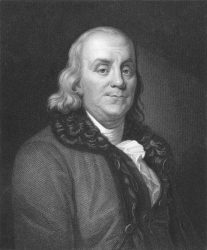 Before the Franklin stove, smoke would fill a kitchen whenever cooking occurred over an open fire in a fireplace. Benjamin Franklin’s metal-lined fireplace had two important elements. First, the stove had a hollow baffle that assisted with heat transfer. Second, the baffle relied on an inverted siphon that moved the heat towards the baffle and away from the fire. This caused the heat to transfer to the room’s air, rather than only the immediate area surrounding the fire.
Before the Franklin stove, smoke would fill a kitchen whenever cooking occurred over an open fire in a fireplace. Benjamin Franklin’s metal-lined fireplace had two important elements. First, the stove had a hollow baffle that assisted with heat transfer. Second, the baffle relied on an inverted siphon that moved the heat towards the baffle and away from the fire. This caused the heat to transfer to the room’s air, rather than only the immediate area surrounding the fire.
Unfortunately, the inverted siphon, which was cold and set in the floor, cooled the smoke too quickly. With no draft, the heat could not transfer easily. David Rittenhouse modified Franklin’s invention, and the stove became quite popular. However, since Franklin was far more famous than Rittenhouse, the stove still bears Franklin’s name.
The Lightening Rod – Benjamin Franklin (1749)
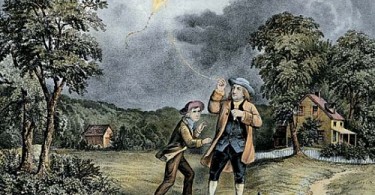 It’s no secret that Benjamin Franklin was a busy man. He first detailed the principle of the lightening rod in 1749, later developing it for household applications in 1753. Franklin’s contribution to the understanding of the relationship between lightening and electricity centered on his testable hypothesis. Supposedly, Franklin himself tested his hypothesis in his famous Kite Experiment in June 1752. Joseph Priestly (who we’ll come back to in a minute) gave an account of the experiment in a formal statement in 1767. Whether Franklin actually tested the experiment remains disputed; however, Franklin’s proposals formed the foundation for capacitors and our modern understanding of electricity.
It’s no secret that Benjamin Franklin was a busy man. He first detailed the principle of the lightening rod in 1749, later developing it for household applications in 1753. Franklin’s contribution to the understanding of the relationship between lightening and electricity centered on his testable hypothesis. Supposedly, Franklin himself tested his hypothesis in his famous Kite Experiment in June 1752. Joseph Priestly (who we’ll come back to in a minute) gave an account of the experiment in a formal statement in 1767. Whether Franklin actually tested the experiment remains disputed; however, Franklin’s proposals formed the foundation for capacitors and our modern understanding of electricity.
The Spinning Jenny – James Hargreaves (1764)
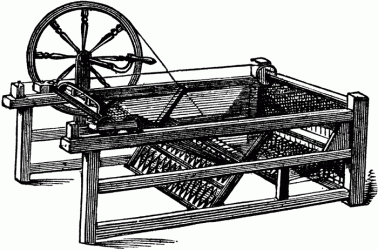 The Industrial Revolution of the 18th century saw many changes, enabling larger-scale production. Before James Hargreaves’ Spinning Jenny, cotton spinners would weave one thread at a time. The Spinning Jenny increased the number to 8, then 80. This change led to the spinning of cotton moving from the cottage to the factory. Not isolated to the colonies, cotton factories sprang up throughout England. One of the consequences of this development, however, was the employment of many young children who were skilled at moving quickly and keeping up with production lines.
The Industrial Revolution of the 18th century saw many changes, enabling larger-scale production. Before James Hargreaves’ Spinning Jenny, cotton spinners would weave one thread at a time. The Spinning Jenny increased the number to 8, then 80. This change led to the spinning of cotton moving from the cottage to the factory. Not isolated to the colonies, cotton factories sprang up throughout England. One of the consequences of this development, however, was the employment of many young children who were skilled at moving quickly and keeping up with production lines.
Carbonated Water – Joseph Priestley (1767)
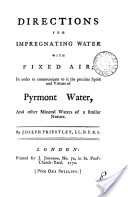 Joseph Priestly not only provided a statement about Franklin’s Kite Experiment in 1767, he also patented soda water or carbonated water. Originally from England, Priestly fled to Pennsylvania to work as a scientist. Here, he created carbonated water by collecting “fixed air”, or carbon dioxide. In a 1772 pamphlet titled “Impregnating Water with Fixed Air”, Priestly detailed his methodology of fusing water with carbon dioxide, leading to soda water. In addition to his work with carbonated water, Priestly is credited with the discovery of oxygen and the invention of the eraser.
Joseph Priestly not only provided a statement about Franklin’s Kite Experiment in 1767, he also patented soda water or carbonated water. Originally from England, Priestly fled to Pennsylvania to work as a scientist. Here, he created carbonated water by collecting “fixed air”, or carbon dioxide. In a 1772 pamphlet titled “Impregnating Water with Fixed Air”, Priestly detailed his methodology of fusing water with carbon dioxide, leading to soda water. In addition to his work with carbonated water, Priestly is credited with the discovery of oxygen and the invention of the eraser.
The Steam Engine – James Watt (1769)
James Watt did not discover steam power; in fact, as early as the late 1600s, steam power was understood. Watt did create the first functional steam engine, which was then used to change the world of transportation and factory labor. It was while he was repairing a Newcomen engine at the University of Glasgow in 1765, that Watt managed to improve greatly on the engine, adding a separate condenser that remained cool while the other condenser was hot. Although he didn’t necessarily invent the steam engine, he did earn a unit of power (the Watt (W) = 1/746 horsepower or Volt x Amp (VA)).
Also, if someone asks, “Do you know what?”, you can quickly reply, “Yeah. He invented the steam engine.”
The Flushing Toilet – Alexander Cummings (1775)
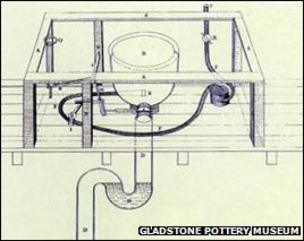 Thank Alexander Cummings and his S-strap for indoor plumbing. In 1775, Cummings patented the first flushing toilet. The S-strap inside the toilet basin – still in use today – works by using standing water as a seal. Joseph Bramah improved on Cummings’ design in 1778 by developing a slide valve with a hinged flap to support the float valve system. The invention of indoor plumbing is instrumental to healthcare. Poor sanitation leads to the spread of many diseases, such as cholera. Indoor plumbing is still considered a luxury to many. Even Mahatma Gandhi recognized this, saying in 1923 that “sanitation is more important than independence.”
Thank Alexander Cummings and his S-strap for indoor plumbing. In 1775, Cummings patented the first flushing toilet. The S-strap inside the toilet basin – still in use today – works by using standing water as a seal. Joseph Bramah improved on Cummings’ design in 1778 by developing a slide valve with a hinged flap to support the float valve system. The invention of indoor plumbing is instrumental to healthcare. Poor sanitation leads to the spread of many diseases, such as cholera. Indoor plumbing is still considered a luxury to many. Even Mahatma Gandhi recognized this, saying in 1923 that “sanitation is more important than independence.”
The Marine Chronometer – John Harrison, Pierre Le Roy, Thomas Earnshaw, And John Arnold (1775)
John Harrison, an English carpenter, presented several proposals for a precise chronometer to the British government. His development of counter-oscillating weighted beams, novel circular balances, and bi-metallic strips are still widely used. The Marine chronometer, which determines longitude by using celestial navigation, was used in this modified form until very recently. In fact, several international mariner certifications still require celestial navigation. Electronic aids, GPS systems, and other emerging technologies are quickly integrating with chronometers to provide improved navigational awareness to ship crews.
The Submarine – David Bushell (1776)
 David Bushnell’s idea was to secretly attach explosive devices to the hulls of British ships. As such, he invented “The Turtle,” an espionage marine vessel designed to do just this. The son of a Connecticut farmer, Bushnell studied at Yale until the university closed early as the American Revolution dawned. At his family farm in Saybrook, Bushnell and his brother developed both the submarine and underwater explosive mines. Although “The Turtle” never successfully delivered a mine, other Continental forces did attack British ships with the devices. Thomas Jefferson publicly announced David Bushnell as the Father of Submarine Warfare at a 1798 lecture at the American Philosophical Society in Philadelphia. A Fourth of July hero!
David Bushnell’s idea was to secretly attach explosive devices to the hulls of British ships. As such, he invented “The Turtle,” an espionage marine vessel designed to do just this. The son of a Connecticut farmer, Bushnell studied at Yale until the university closed early as the American Revolution dawned. At his family farm in Saybrook, Bushnell and his brother developed both the submarine and underwater explosive mines. Although “The Turtle” never successfully delivered a mine, other Continental forces did attack British ships with the devices. Thomas Jefferson publicly announced David Bushnell as the Father of Submarine Warfare at a 1798 lecture at the American Philosophical Society in Philadelphia. A Fourth of July hero!
Whether it’s your “necessary house” (bathroom) or your “impregnated water” (soda water), the late 18th century gave us many technological advances that improved the lives of future Americans. Of course, the real invention of 1776 was modern democracy. In honor of the Fourth of July, we hope you enjoyed learning about historical technological inventions of the time.
‘Twas a splendid lecture, aye? To that, I say, well be, Madams and Sirs, this Fourth of July!
Contact us today to discuss how to implement 21st century technologies into your industry.
Like what you read?
About Mindsight
Mindsight, a Chicago IT services provider, is an extension of your team. Our culture is built on transparency and trust, and our team is made up of extraordinary people – the kinds of people you would hire. We have one of the largest expert-level engineering teams delivering the full spectrum of IT services and solutions, from cloud to infrastructure, collaboration to contact center. Our highly-certified engineers and process-oriented excellence have certainly been key to our success. But what really sets us apart is our straightforward and honest approach to every conversation, whether it is for an emerging business or global enterprise. Our customers rely on our thought leadership, responsiveness, and dedication to solving their toughest technology challenges.
Contact us at GoMindsight.com.
About The Author
Siobhan Climer, Science and Technology Writer for Mindsight, writes about technology trends in education, healthcare, and business. She previously taught STEM programs in elementary classrooms and museums, and writes extensively about cybersecurity, disaster recovery, cloud services, backups, data storage, network infrastructure, and the contact center. When she’s not writing tech, she’s writing fantasy, gardening, and exploring the world with her twin two-year old daughters. Find her on twitter @techtalksio.

